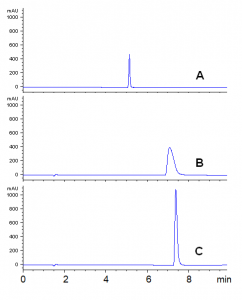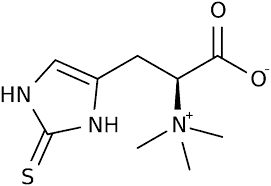Gradient changes with column ID change.
An example is shown below with ergothioneine being analyzed using 4.6×100 mm column and ANP gradient method using UV detection. When the column dimensions were changed from a 4.6mm x 100mm to 2.1mm x100 mm, it may seem the column ID have made the peak efficiency worse.
Column ID has effects on peak height response, back pressure, and elution time. One must keep these variables in mind during column dimension changes. Below is a demonstration of how an adjustment of gradient conditions were necessary to obtain good peak symmetry for this compound.


Peak:
Ergothioneine
Chromatogram A: column A, gradient 1, flow rate: 1 mL / minute
Chromatogram B: column B, gradient 1, flow rate: 0.2 mL / minute
Chromatogram C: column B, gradient 2, flow rate: 0.2 mL / minute
Method Conditions
Column: Cogent Diamond Hydride™, 4μm, 100Å
Catalog No.: Column A: 70000-10P Column B: 70000-10P-2
Dimensions: Column A: 4.6×100 mm Column B: 2.1x100mm
Mobile Phase:
—A: DI water with 0.1% formic acid (v/v)
—B: acetonitrile with 0.1% formic acid (v/v)
Gradient:
| Gradient 1 | Gradient 2 | ||
| time (minutes) | %B | time (minutes) | %B |
| 0 | 90 | 0 | 90 |
| 5 | 50 | 4 | 30 |
| 7 | 50 | 6 | 30 |
| 8 | 90 | 7 | 90 |
Flow rate: A: 1.0mL / minute, Column B: 0.2 mL / minute
Detection: UV @ 254nm
Injection vol.: 1μL
Sample Preparation: 0.1 mg / mL in 90% DI water / 10% acetonitrile with 0.1% formic acid
Note: Ergothioneine is a naturally occurring amino acid and is a thiourea derivative of histidine, containing a sulfur atom on the imidazole ring. Ergothioneine is found mainly in mushrooms, as well as red and black beans.


